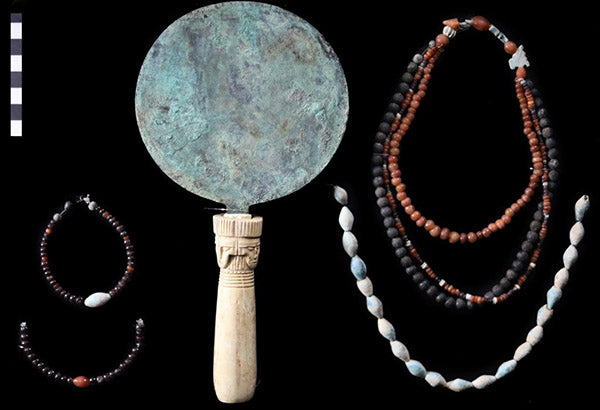A team of archeologists from the US and Egypt has unearthed a jewelry-laden tomb near Luxor that dates back 4,000 years to the 12th and 13th Dynasties. The team discovered beautiful necklaces, bracelets, armlets, scarab rings and decorative belts made of amethyst, carnelian, garnet, blue-green glazed faience (ceramic) and feldspar.
The amulets feature carved gemstones that resemble characters of the natural and spiritual worlds: a hippo, hawk, snake, ba (bird with human head), Eye of Horus and the fertility goddess Taweret, among others.
One standout necklace is strung with 30 amethyst barrel beads with an amazonite ba-shaped amulet in the center. Another exquisite piece is a belt crafted of carnelian ball beads connected by double strings of blue faience ring beads.
Two burials also contained copper or copper alloy mirrors with elegantly carved ivory handles.
The items were discovered by the Egyptian-American mission South Asasif Conservation Project, which works under the auspices of Egypt's Ministry of Tourism and Antiquities. The Middle Kingdom tomb with 11 intact burials was found as the team was clearing the south side of the superstructure of the 25th Dynasty tomb of Karabasken.
While the burials were significantly damaged by previous floods, which destroyed the wood of the coffins and the linen wrappings, items that were impervious to water remained intact. This is why the recovered jewelry is in such pristine condition. The jewelry was found "in situ" (in its original positioning among the skeletal remains), which allowed the team to determine how the jewelry might have been worn.
According to Dr. Afaf Wahba, the burials contained the skeletons of five women, two men and three children. It is believed that they represented many generations of the same family.
Dr. Wahba noted that most of the jewelry was found in among female burials. The children and one of the men did not have any burial goods.
Interestingly, one of the male burials contained what he called "an imposing necklace" consisting of 40 faience ball beads, each separated by a single faience cylinder bead. Two cylindrical carnelian beads flank a hippo head amulet on the back.
The items in the tomb date back to the 12th and 13th Dynasties of Egypt (1938 BC-1630 BC). The tomb is the first from the Middle Kingdom period to be discovered in the South Asasif area, which is located near the west bank of the Nile next to the Temple of Hatshepsut.
Credits: Images courtesy of the South Asasif Conservation Project.






